Dell XPS 13 Review
by Brett Howse on February 19, 2015 9:00 AM EST- Posted in
- Laptops
- Dell
- Ultrabook
- Broadwell-U
- XPS 13
Display
Dell offers two display choices in the XPS 13. The base model comes with an IPS 1920x1080 (Full HD, or FHD) Sharp 1420 panel, with LED backlighting of course. The upgrade is to the Sharp 1421 panel, which increases the resolution to 3200x1800 (QHD+), for 272 pixels per inch. Even 1080p on a 13.3 inch panel is a nice resolution, but the high DPI display really shines, especially in the new Windows 8 environment. Desktop apps can still have some issues with High DPI, but it is becoming less of a problem over time.
Sharp is the maker of all IGZO displays, which we have seen before in a couple of other devices such as the Razer Blade. The big benefit to IGZO (Indium Gallium Zinc Oxide) panels is they allow more light through the display, reducing the power requirements for the backlight. This generally means that we get to keep the full RGB stripe, which should help with color accuracy.
Being able to see both sets of pixels just shows how many more pixels are packed into the High DPI panel. 1080p is around 2 million pixels and 3200x1800 is 5.76 million pixels. It is a big difference and gives a big increase to clarity, but it comes with the cost of increased power usage, despite the IGZO TFT.
Dell has the displays listed as IPS (In-Plane Switching) panels on their spec sheet, and they do not seem to have any of the off-angle color shift of a VA (Vertical Alignment) design. Whatever the display type, it certainly is not TN (Twisted Nematic) so even at extreme angles there is not the loss of contrast associated with those displays. Also, you can see the anti-glare coating on the FHD pixels, which is the distortion shown on the subpixels.
To test the panels, we turn to SpectralCal’s CalMAN 5 software suite, the X-Rite i1Display Pro Colorimeter for brightness and contrast measurements, and the X-Rite i1Pro Spectrophotometer to measure the color accuracy.
One more note about the Dell displays though is that they have an auto-brightness adjustment with no way to disable it. It seems to manifest itself the most, and the most severe, when there are large contrast changes on-screen. For this reason, our automated testing for the color accuracy would not work at all because of the abrupt changes on the screen as it flashed among the various colors. This would cause the screen to go bright and dim and caused some very erroneous readings.
I was able to get around it for the color testing by manually going to on-screen color patterns, however display calibration is impossible with this brightness adjustment so that was skipped. I have contacted Dell to inquire about this issue and will give an update if they get back to me.
Update: Dell has enabled Content-Adaptive Backlight Control, which we have seen in other devices like the Nokia Lumia 930. Dell has let me know they are looking into a way to have the end user disable this feature.
First up is the brightness, contrast, and black levels.
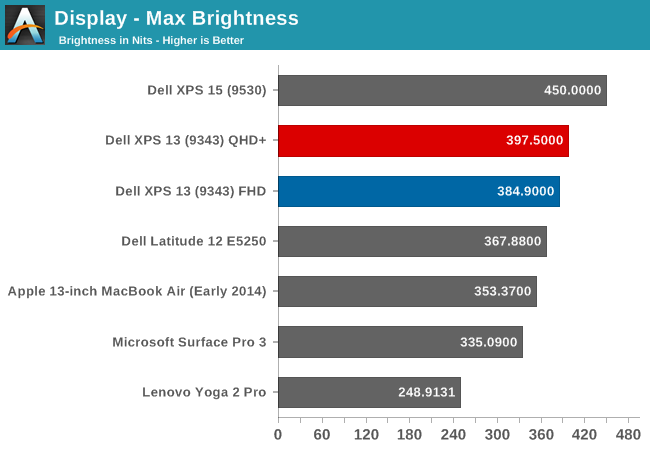
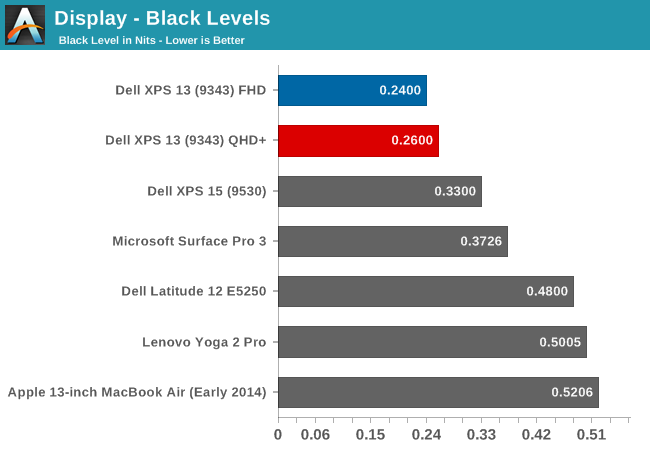
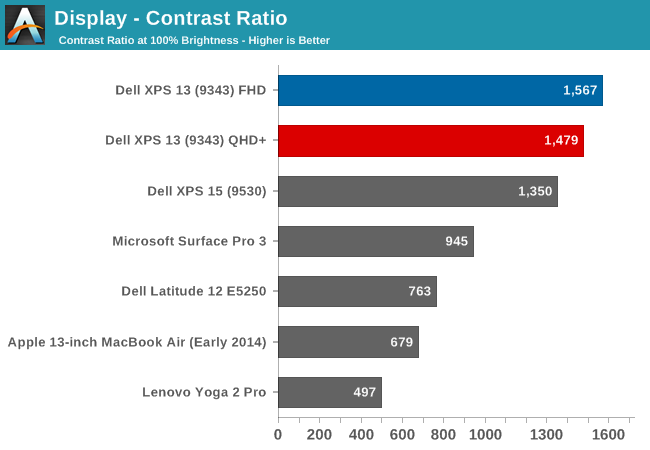
Both displays get very bright. Dell claims 400 nits brightness on the XPS 13 and we measured almost that much. Also, the black levels were very good on both displays, giving a contrast ratio close to 1500:1 on both units. Minimum brightness is around 16-17 nits on both models as well, so there is quite a bit of range on the displays to let them work on almost any situation.


On the QHD+ version, grayscale is a decent result, coming in around delta E of 3. The gamma unfortunately really drops off at the upper end of the range. The color temperature is a bit warm, and as the chart shows, the greens are a bit high. The FHD model does not fare so well, with the gamma going quite high, and the grayscale DE being almost 6.
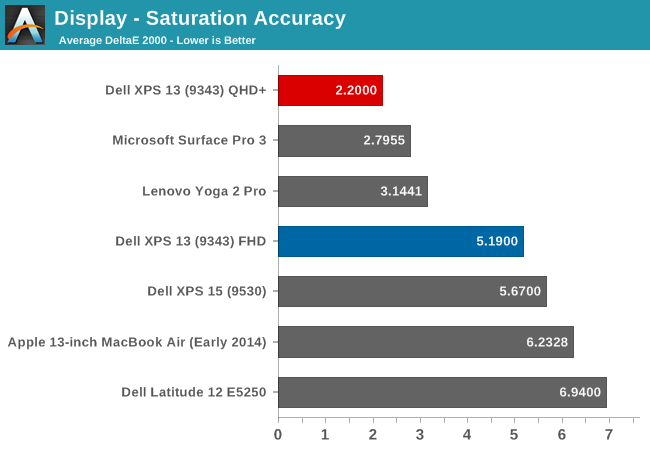
Dell does well on the saturations, with both displays being able to do the entire sRGB color space. Once again, the QHD+ model scores a lot better, with the saturation a very nice 2.2 dE, while the FHD version is closer to 5 - not an awful result, but much worse than the upgraded model.
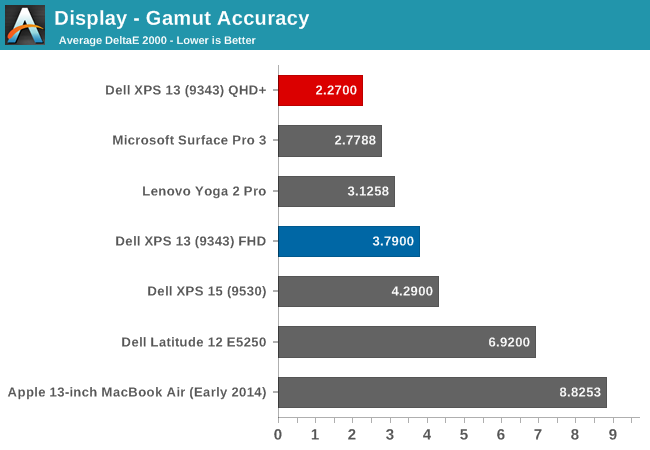
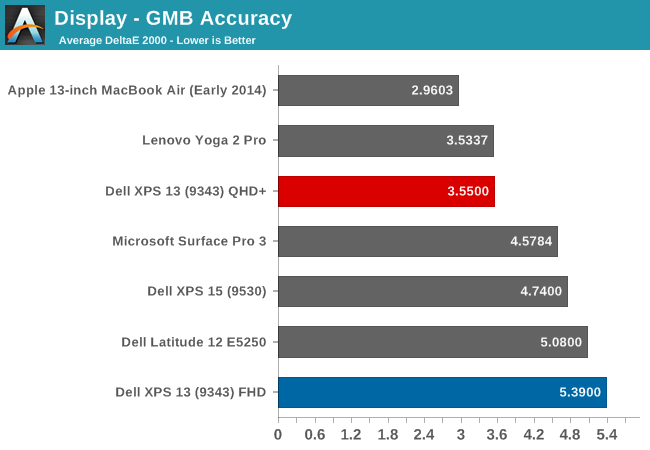
Wrapping up with the Gretag Macbeth results, again the QHD+ model does very well, with the FHD model just average. I have to note though, that even though the GMB score was very good on the QHD+ model, all of the colors that were off, with some of them around DE of 6, were the skin tones. Without calibration, anyone wanting to use this for photo editing may not much enjoy it, and with the auto-brightness issue, the calibration will not work so there is no way to see if the scores improve after calibration.
The Infinity Display is certainly one of the defining characteristics of the XPS 13, and especially with the QHD+ version the color accuracy and other characteristics are quite good. The Auto-Brightness is certainly an issue, and hopefully Dell will offer up a way to disable this either in software or the BIOS soon.


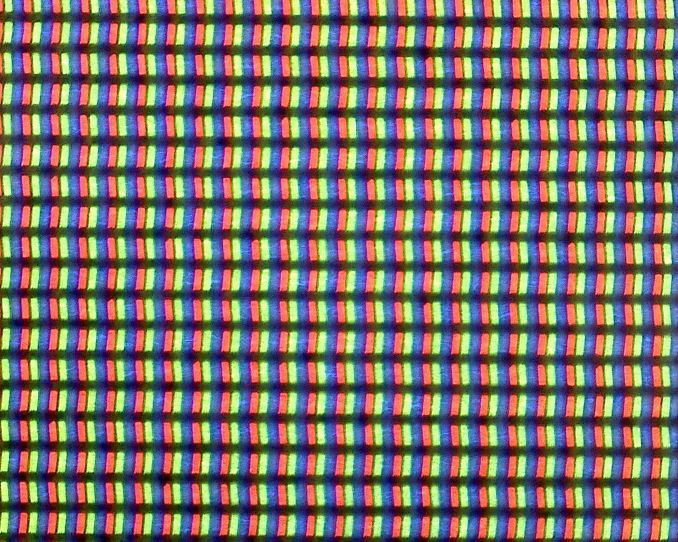
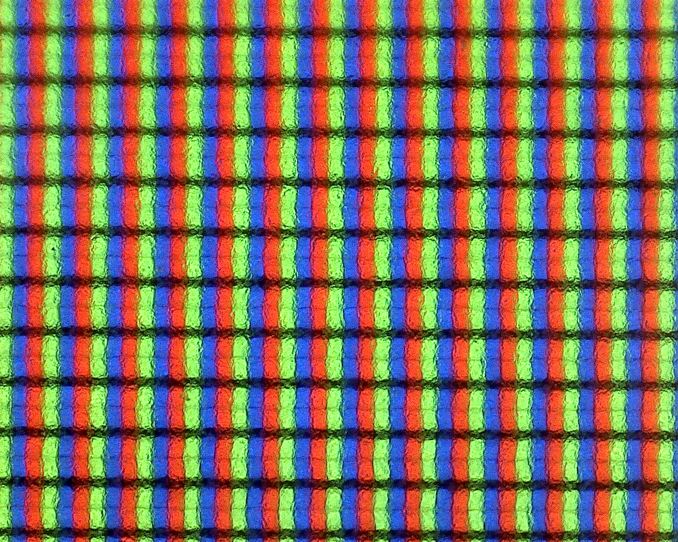
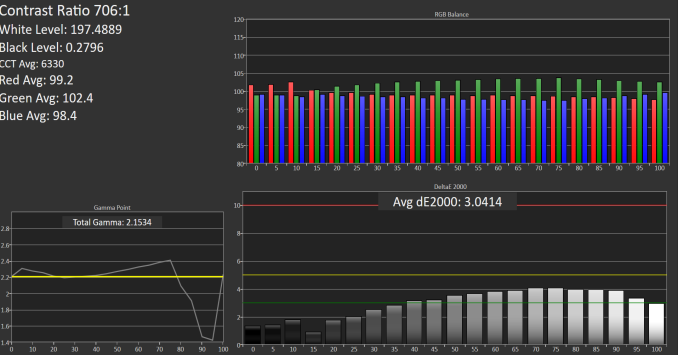
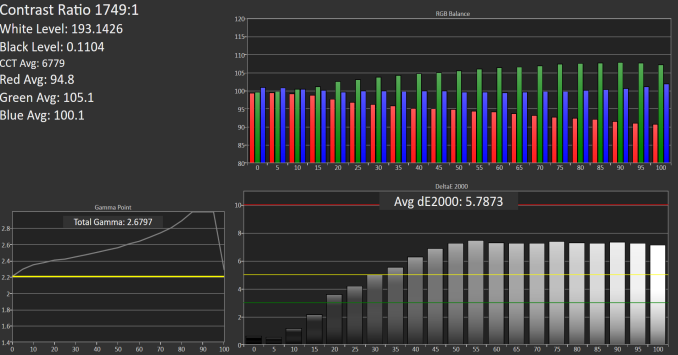
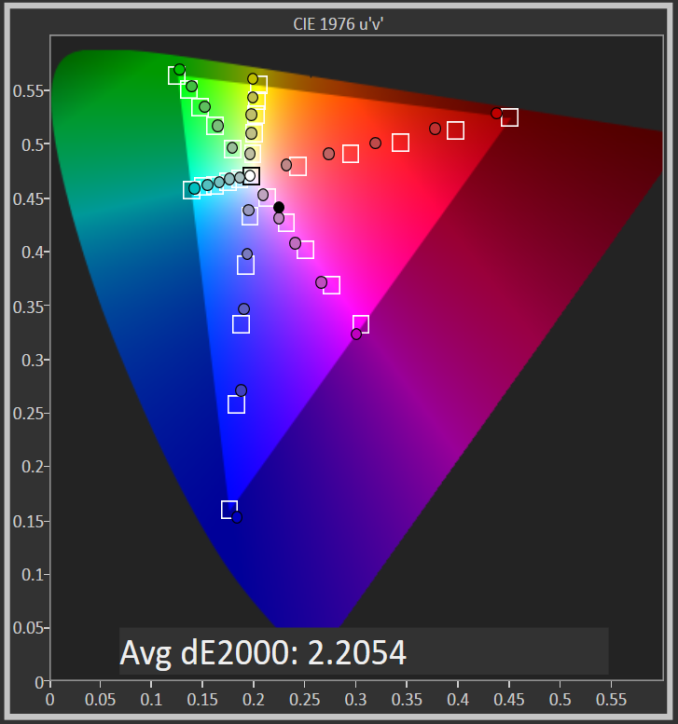

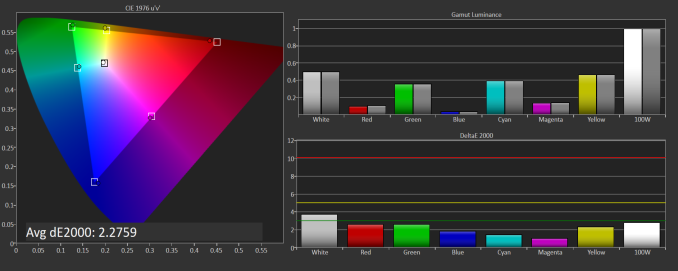
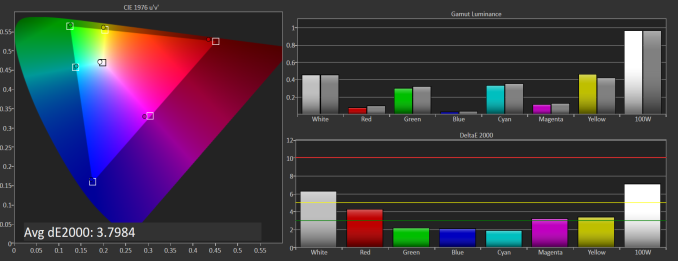

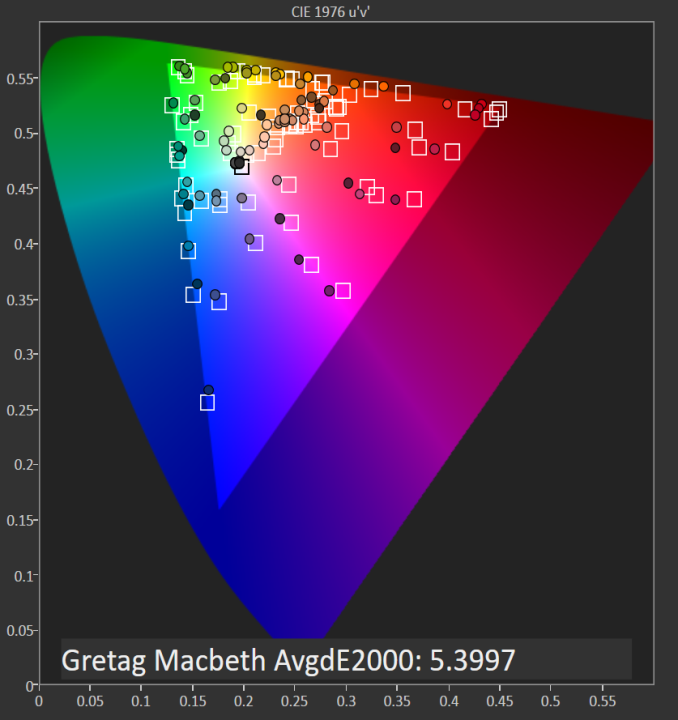








201 Comments
View All Comments
qasdfdsaq - Friday, February 20, 2015 - link
Apple charge £120 to upgrade from a 1TB drive to a 3TB drive in an iMac 27". These are standard 3.5" desktop drives. The price difference between a 1TB drive and 3TB drive at retail is about £35. £120 may not sound like much but that's still 350% more than free market prices.Then there's the £800 for a 1TB SSD. Market prices are around £350. It's rather irrelevant if you can find a Samsung XP951 cheaper, they do not at any point advertise it being a Samsung XP951.
Even so, a 512GB XP951 costs £340 at retail, whereas the 'Apple cost' for it is around £450. And this is in a 27" iMac that can easily fit two, if not four 2.5" SSDs which would offer comparable storage and performance at less than half the cost - but they don't offer the option. Deliberately offering a very expensive option with no real advantages is the pretty much the definition of price gouging (note that I'm not referring to the US legal definition here)
Synomenon - Thursday, February 19, 2015 - link
So what's gaming performance like b/w the QHD+ and FHD versions if BOTH have 8GB of RAM?Jon Tseng - Thursday, February 19, 2015 - link
Interesting - all credit for testing QHD vs. FHD. I'd seen the other reviews (QHD only) showing mediocre battery life and had been wondering why 14nm was't delivering an improvement!odedia - Thursday, February 19, 2015 - link
I can't believe you published this but still didn't publish the iMac 5k review. Disappointing.Ryan Smith - Thursday, February 19, 2015 - link
To be clear, Brett's job here is to look at laptops and WinPhone devices. The iMac is my task, and what Brett works on has no impact on that.Samus - Thursday, February 19, 2015 - link
Dell's still trying to shake off their poor reputation during the 00's, especially with bomb's like the Inspiron 700mBut this is a solid machine.
piroroadkill - Thursday, February 19, 2015 - link
The Inspirons may have been shite back then, but I recall fondly the Latitudes and Precisions of those days. Chunky beasts, yes, but it was a period when you could get high res screens in a decent chassis. 1400×1050 14", 1920×1200 15", 1600×1200 15".. blah, blah.. Got a D800 that still works fine, with Radeon 9600 GPU. Hot shit for the time.bznotins - Thursday, February 19, 2015 - link
Wow, looks like a really nice laptop. I've always wondered why bezels had to be so large.I'm typing this on a 13" 2013 Retina MBP. Now that Windows is starting to get high dpi scaling into better shape, and vendors like Dell are making nice high-dpi hardware, I might be able to finally come back to the PC world. OSX just isn't that great, and running Windows on a mac isn't that great either.
Steveymoo - Thursday, February 19, 2015 - link
Looks like the laptop to beat for travelling photographers!John_dune - Thursday, February 19, 2015 - link
Brett, there is one question this review has left me, and it seems like a fairly big one... is there any aftermarket upgradability with this device? I currently have an Acer TimelineX 3810 that's almost hitting the end of its life, and i find that i don't really use the dedicated graphics for anything, and I was thinking about upgrading to this laptop. Would i be able for example to upgrade the ram myself to 8gb? or be able to put in a 512gb ssd (i'm assuming it's not a 2.5 inch hdd in there)?